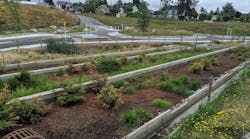A Sustainable Infrastructure Paradigm: Engineers As Agents of Change
Bradley Striebig’s photos of Kigali show brilliant terracotta hills with patchworks of bright green foliage, hibiscus, Plumeria, and bougainvillea. Kigali is the capital of Rwanda, a country smaller than the state of Maryland and densely populated with 8.6 million people, 90% of which are engaged in agriculture, primarily tea and coffee.
Located just south of the equator and close to the center of Africa, Kigali’s landscape of rolling hills resembles the Mediterranean but with a Hawaiian patina. Unexpected as this setting is, the Engineers Without Borders–USA (EWB) project there is more astonishing.
Striebig is an assistant civil engineering professor at Gonzaga University in Spokane, WA, and advisor of his campus’s EWB chapter project in Kigali. On his first trip in mid-September he acted as the water-quality technician (and unofficial photographer).
“We went there to test the water in an area that is fairly rural but on the periphery of the town,” Striebig says. “In one place we walked to the tap stand that runs out every day near a school. We had to take the last quart from the tap stand to test. They actually have enough water—the rainwater is good when it comes out of the sky—the groundwater and surface water is heavily contaminated. They have enough quantity, but what they need is water management, storage, capture, and use so that it’s affordable and drinkable.
“I’ve got four teams of students. They’re working on subtopics: modeling the water quantity where it is and how to deliver it to the Kimisange area [of Kigali].”
The sustainable water infrastructure design project Striebig is talking about turns out to be merely the tip of the iceberg of EWB’s most ambitious, large-scale, and thoroughly integrated project so far.
Though Kigali was the site of horrific genocide in 1994, it is no longer divided by conflict. It has much to look forward to—too much, in fact. Kigali is expected to grow from the current population of 900,000 to nearly 3 million by 2025. Growth will be greatly complicated by Rwanda’s lack of infrastructure, building codes, access to energy resources, and water problems.
What Kigali needs most is a master plan for investment in infrastructure that will allow it to support its current population plus the repatriation of those who left because of the genocide. This is a massive project on a scale comparable to reconstruction efforts after the Katrina hurricane or the tsunami in the Indian Ocean. A team, led by Oz Architecture out of Denver, CO, was selected to work on this master plan. As a part of this team, Tetra Tech Inc. was asked to provide the civil and environmental engineering.
Cathy Leslie, P.E., executive director and co-founder of EWB and project lead for Tetra Tech on the Kigali Master Plan project, explains, “Rwanda is very progressive and very visionary, which has resulted in a very safe investment climate. Rwanda wants to be the country that provides the model of environmental and sustainable development within Africa. Rwandese have some natural resources but are very entrepreneurial and use what they have in a very innovative manner.”
Mark Reiner is an engineer for Tetra Tech’s Kigali Master Plan project. He started volunteering for EWB with Cathy Leslie in 2002, while working full-time at Tetra Tech. Now he’s a full-time Ph.D. student at the University of Colorado at Denver and stepped down last month as EWB’s projects director so he can focus on school and the Kigali Master Plan. “The Master Plan is a legal document,” he says, “for planning and implementing infrastructure. The three consultants on the project are OZ Architecture, EDAW, and the infrastructure is Tetra Tech. Cathy and I are with Tetra Tech, and we’ve been driving the infrastructure.”
Leslie says, “We’ve pulled EWB into the Master Plan because EWB is a grassroots community-based organization and can do projects that companies such as Tetra Tech can’t. Large firms cannot do some of the grassroots type of projects that EWB is good at. Eventually as some of these bigger projects get on board, EWB will do some of the smaller projects that wouldn’t necessarily get funded.”
In a nutshell, the Master Plan project aims to tackle all of Kigali’s infrastructural problems utilizing some wildly inventive elements that were a result of EWB workshops. For example, two workshops held by the Kigali City Council, Kigali Institute of Science and Technology, and EWB promoted technologies such as low-cost, sustainable homebuilding material; home-scaled biogas digesters for fueling cooking stoves; constructed wetlands for stormwater treatment; and gravity-fed wastewater energy production that leverages Kigali’s hilly topography. There’s also the unifying concept promoted in the Kigali Master Plan of Environmental Treatment Zones. The project is a paradigm for large-scale integrated sustainable infrastructure. If you’ve ever dreamed of designing the ultimate sustainable SimCity, Kigali might become that city.
“It’s pretty ambitious. It’s necessary. This is the kind of project that if you can pull it off you’ve made a huge difference,” Leslie speaks from experience. “You can affect the health and quality of life for over a million people. It’s pretty intimidating. And we’re pushing the limits—we’re not only thinking outside the box; we don’t even know there’s a box. Here in western conventional thinking you do something to address one or two things. Over there we’re throwing out conventional thinking and asking, “˜What else can it do? Can it create energy? Micro-enterprise?’ The Rwandan people are leading the charge and we’re trying to keep up with them.”
According to Striebig, “The civil engineers at the Kigali Institute [of Science and Technology] have a biogas digester design based on a Chinese model that they’ve used for a prison system, so they know what the volume is.”
Reiner summarizes, “In Rwanda they don’t do anything if it’s not sustainable due to the national economics. They’re doing a great job already, so what we’re doing is tying it all together with gravity. The key concept for the Master Plan is Environmental Treatment Zones [ETZs]. We divided Kigali into 23 watersheds, and we use gravity to bring all of the stormwater and wastewater to different treatment zones. We decided not to do this with a western mindset because they don’t have fossil fuel resources or rail as a cheap means to transport the fuel typically required for pump stations or lifting, so we looked at it as what is a sustainable way to approach this. Right now they have good storm drain channels on their roads, but it just brings all pollutants into the natural wetlands. We are proposing baffles, energy dissipaters, and the stormwater will be sent into constructed wetlands such as bamboo or sugar cane as treatment before it goes to natural wetlands.
“Wastewater will be taken by gravity through a herringbone pipe system to the biogas digester. Food markets throughout the city produce wet organics. These will move downhill to the ETZ for soil composting. Dry organics can be made into briquettes for fuel. Anything that can’t be recycled is moved uphill by people and gets picked up and sent to a solid waste facility.”
This summer Reiner helped organize three workshops to begin long-term collaboration. The workshops were sponsored by the Kigali City Council, the Kigali Institute of Science and Technology, and EWB and served to demonstrate how the many inputs will work in concert on a scale never before attempted.
The first workshop, held in June 2006, developed and tested earth bricks stabilized with naturally abundant lime that will be used in homebuilding. The second, held in September, detailed the biogas digester, rainwater collection, the constructed wetlands, and the gravity-fed energy production system. The third workshop is a demonstration home that will feature all of the elements.
“It’s almost done except for the roof,” says Reiner of the home. “It’s taken a few months for us to explain the ETZ concept of infrastructure implementation. The pilot project to show this in action would go a million miles.”
Leslie adds, “We haven’t really quantified the energy production at this point—just more. We would like to cut down on deforestation. It would be nice to produce 50% of their cooking energy. In other areas which have no access to electricity or forest we may have to have to produce 100%.”
But they do have gravity on their side. As Striebig explains, “[The] gravity of the water falling out of the sky—it’s the only energy that’s affordable and available in Rwanda. It’s such a different mindset because energy is so cheap here. At the municipal scale in this fashion—it’s probably been done in China. In India it’s also been done at the household level. What we’re talking about is a little different—to look at the cost-benefit of the economy of scale.”
Striebig is a bit awed. “I think this is terribly exciting, and I feel quite privileged to be part of it: to go somewhere and see how this idea of energy and lack of energy influences your design. I took my textbook and dropped it in the trashcan because [the way we normally approach infrastructure] relies on energy being cheap. And it’s not in Rwanda so we have to start over.”
Reiner says of the obstacles, “It’s much different than planning in the US as Kigali is a city where 80% live informally without legal land title and it’s a major concern. The city popped up like a village without order or roads. It has been a challenge of what to do without material or building codes.”
For Leslie, “It’s the opportunity of a lifetime. I never thought I could mix my day job with my volunteer job. Tetra Tech has been very supportive. Tetra Tech has the corporate philosophy of wanting their employees to take ownership of their projects. They are very supportive of new ideas—they encourage us to do this.”
Leslie, Reiner, and Striebig all see that the success lies in community enterprise that will produce the necessary inputs.
“They need all sorts of materials and resources,” says Leslie in her characteristically calm voice. “There’s not a lot of pipe manufacturers in Rwanda. They have no one who makes erosion control devices. They produce milk locally, but they have to ship all of their milk for packaging. The majority of people dig their clay out of the ground to make into bricks for their homes. They burn dung and charcoal rather than using efficient gas stoves. There are so many ways to improve many things which will affect their quality of life that you can just open your mind and run with that.”
Will infrastructure make Kigali a boomtown for global corporations or a sustainable eco-city built on a foundation of social justice? Could it be both? How can EWB work to ensure that new infrastructure supports a society already in step with the environment? Stay tuned for the next installment.


